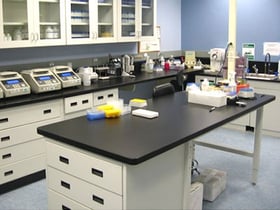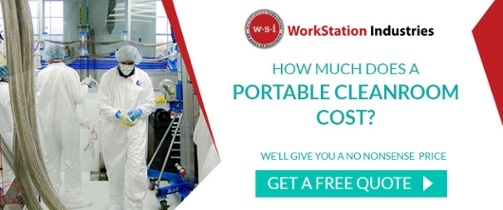Designing a clean room that operates efficiently and safely already comes with its own set of challenges.
It is important not to overlook the important role furniture plays in how effective a clean room operates. After all, even if a clean room is designed properly, if the furniture and procedures that occur inside a clean room do not align with the room’s purpose, a project may be compromised.
The good news is there are industrial furniture manufacturers who are willing to work with you to design and customize the best clean room furniture for your space.
When choosing materials for your clean room furniture, it is important to take into consideration your current needs, as well as your future needs. Here are some additional do’s and don’t of designing clean room furniture and casework so that you can have peace of mind that your space is operating at high efficiency.
Do Take Into Account Your Application
When choosing the material for your modular clean room furniture, you should consider the material’s resistance to substances you work with and any environmental factors such as heat and moisture.
For example, when examining countertops, look for how resistant the materials are to issues commonly found in a clean room space.
- Phenolic resin tops are typically used in labs and are designed as one solid, lightweight countertop that is durable and long-lasting. It is highly resistant to bacteria, chemicals, fungus and moisture.
- Epoxy resin are also highly resistant to bacteria, chemicals, fungus and moisture, along with corrosion. They are durable and non-porous, and hold up well under harsh conditions such as high heat.
- ESD laminate tops are ideal for applications where parts and materials are sensitive to static and need protection.
- Chemical resistant laminate tops are highly resistant to chemicals and extreme applications. They are among the more affordable choices.
Other options include stainless steel, high pressure laminate and butcher block. Our article, Top 5 Materials To Consider For Your Lab Countertops, further explores some of these choices outlined above.
When looking at clean room chairs, material can be extremely important. There are three options that are typically used in laboratory and industrial applications … fabric, vinyl and polyurethane.
Fabric tends to provide the most comfort, but it doesn’t hold up well in many clean rooms. Vinyl and polyurethane hold up better in spaces where chemicals are present. Vinyl resists stains more and is easier to clean, and polyurethane is appropriate for work in harsh conditions.
Finally, your application can impact the load of the workbench you choose as well. Before purchasing any type of workbench for your clean room, know at what level you need it to perform. This includes the weight load capacity and the strength of the workbench.
You can read more about the differences among standard, heavy duty and extra heavy duty capacities in our article, How To Customize An Industrial Workbench With Storage.
Don’t Overlook ESD Factors
Static electricity can be a major problem in many clean rooms. If this is the case in your clean room, it is important to ensure Electro Static Dissipative (ESD) requirements are put into place. These requirements extend to the equipment and materials located inside the clean room.
If ESD requirements are overlooked, static electricity can impact precision weighing and cause safety hazards.
As mentioned above, ESD laminate surfaces are ideal for applications that have these requirements. ESD chairs can also be incorporated into a space. These chairs typically feature a fabric or vinyl material that prevent a charge created by friction.
Do Consider Placement
When designing any piece of furniture, it is important to consider where this piece of furniture will be placed in the clean room.
All pieces of furniture and equipment associated with critical processes in a clean room should be placed away from high traffic areas, doors and other places that could interfere with these processes. Because of this, the design of your furniture may be impacted in order to fit a certain space.
One other important note: Many clean rooms have fume hoods. In order for a fume hood to work properly, air disturbances must be minimized. To accomplish this, furniture with proper storage should be available for materials so that chemicals or lab equipment are not placed under the hood.
Don’t Forget Storage
Storage is an often overlooked component when designing clean room furniture. In fact, it can be one of the most important pieces of industrial furniture design to consider since it can be designed to accommodate both current and future needs.
Working with an industrial furniture company that offers customization is a great way to add storage options to a work area while increasing productivity and saving space.
Here are a few space-saving options to consider when customizing an industrial workbench with storage:
 Utility drawers
Utility drawers- Shelving
- Upper storage cabinets
- Articulating monitor arms for flat screens and laptops
- Keyboard trays
- CPU holders and pegboards
- Bin rails or panels
Do Encourage Good Health
Numerous studies show sitting in the workplace can be hazardous to one’s health. Some have even said sitting is the new smoking.
The health of your employees should be a top priority. Medical issues can result in a heavy cost for both employees and employers.
Furniture designed for clean rooms and other industrial and laboratory spaces has come a long way in design, with many pieces offering ergonomically-friendly options. New innovations like hydraulic adjustable workstations and benches provide a possible solution to this growing concern.
Many pieces of clean room furniture come with tremendous flexibility, allowing workers to adjust their workstations based on their height and body types. These adjustments can make workers more comfortable and reduce the risk of injuries or health issues caused by overexerting or too much sitting.
Don’t Underestimate The Importance Of Quality
Finally, when designing clean room furniture for your space, a major “don’t” is to never underestimate the importance of quality.
Industrial furniture is a significant investment, especially if you have a sizable operation and are upgrading several new workstations. Choosing a high-quality product is critical in order to protect your long-term investment.
One way you can protect your investment is to look for third-party certifications, such as:
- Underwriters Laboratory (UL)
- American National Standards Institute/Business and Institutional Furniture Manufacturers Association (ANSI/BIFMA)
- Scientific Equipment and Furniture Association (SEFA)
These organizations certify components of a piece of furniture, as well as the whole piece of furniture itself, as having met a certain set of quality and safety standards.
Ensuring the clean room furniture you purchase meets these standards, as well as by keeping in mind the do’s and don’ts of design outlined above, will help ensure your investment is a sound and long-term solution to meet the needs of your space.



